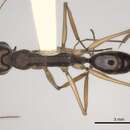en
names in breadcrumbs


Taxonomic history
Sorger & Zettel, 2011 PDF: 150 (q.).Senior synonym of Odontomachus infandus striaticeps: Brown, 1976a: 104.Ich erhielt diese Art von Herrn Dr. Sichel aus Manilla.
Worker. Length 6 lines.-The head and thorax ferruginous, with a fine silky grey pile; the antennae ferruginous; the legs pale testaceous, with the tarsi dusky. The mandibles serrated on their inner edge, the teeth increasing in size towards the apex of the jaws, which are suddenly bent at their extremity and armed with three teeth, the inner one shortest; the deep sulcations on the face between the eyes, smooth and shining, the hinder portion finely and obliquely striated; the head, behind the sulcation, striated on each side obliquely from the centre. The prothorax with fine curved longitudinal striae, that on the meso- and metathorax transverse. The node of the abdomen terminating above in a long, slightly curved, acute spine, the base of the node with a blunt tooth beneath.
Hab. Philippine Islands. (Coll. H. Cuming.)
Notwithstanding the great similarity of all the species of this genus, and particularly between this and the O. maxillaris , the great difference in the serration of the mandibles will at once distinguish them.